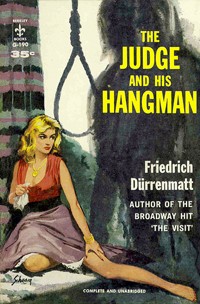 Swiss writer Friedrich Dürrenmatt is one of the most highly regarded 20th century dramatists of the German-speaking world. Early on in his career, however, he turned to crime fiction and wrote The Judge and His Hangman for a very personal reason – he needed money to pay his wife’s hospital bills. More credit to him then, that the ‘potboiler’ he produced in 1950, published in serial format in a newspaper over the course of a few months, has become a classic of crime fiction.
Swiss writer Friedrich Dürrenmatt is one of the most highly regarded 20th century dramatists of the German-speaking world. Early on in his career, however, he turned to crime fiction and wrote The Judge and His Hangman for a very personal reason – he needed money to pay his wife’s hospital bills. More credit to him then, that the ‘potboiler’ he produced in 1950, published in serial format in a newspaper over the course of a few months, has become a classic of crime fiction.
 The novel itself is very short – more of a novella really – but full of questions and moral dilemmas. Inspector Bärlach of the Bern police is slowly dying of cancer, but he is careful not to let any of his colleagues know. His boss is enamoured with the advanced technology and forensic policing methods being introduced in the US but, despite his own experience abroad, Bärlach prefers to rely on his own intuition and profound understanding of dark side of the human psyche. In a sly reference to Switzerland’s ambiguous neutrality during World War II, the author states that the inspector worked in Germany until 1933, when he slapped someone in the new government there and was therefore recalled to Bern. Once back in Switzerland, his actions were viewed as, “…first shocking, then regrettable but somewhat understandable, and finally as the only possible attitude for a Swiss – but only in 45.”
The novel itself is very short – more of a novella really – but full of questions and moral dilemmas. Inspector Bärlach of the Bern police is slowly dying of cancer, but he is careful not to let any of his colleagues know. His boss is enamoured with the advanced technology and forensic policing methods being introduced in the US but, despite his own experience abroad, Bärlach prefers to rely on his own intuition and profound understanding of dark side of the human psyche. In a sly reference to Switzerland’s ambiguous neutrality during World War II, the author states that the inspector worked in Germany until 1933, when he slapped someone in the new government there and was therefore recalled to Bern. Once back in Switzerland, his actions were viewed as, “…first shocking, then regrettable but somewhat understandable, and finally as the only possible attitude for a Swiss – but only in 45.”
When one of his best educated and most promising young detectives is found shot in his car on a remote country road in the Jura mountains near Biel, Bärlach is assigned to the case. The elderly inspector partners with young Tschanz, whose methods are the opposite to Bärlach’s. Tschanz is systematic and thorough, checking the body, asking questions of the landlady and other people who knew the victim. Meanwhile, Bärlach seems to float around in a bubble of non-action and sadness. He tells his partner that he already suspects someone but refuses to say who, so as not to influence the investigation.

Author Durrenmatt relaxing with paper.
Whose right is it to punish?
The investigation seems to implicate powerful industrialist Gastmann, whom Bärlach has been chasing unsuccessfully for years. But is Gastmann really guilty of this latest murder, or is the policeman too eager to punish someone for his criminal activities as he nears the end of his life? This fusion of existentialist philosophy and detective fiction begs the fundamental ethical question: are we ever justified in meting out our own justice, even if we know the person we are punishing richly deserves it? Interestingly enough, the author originally intended to let his main protagonist die of cancer, but his editor convinced him to change the ending to have the option of writing an additional novel featuring the Inspector.
Dürrenmatt’s style is succinct yet full of depth and colour. His dialogue is brilliant – befitting of a playwright – but he is equally successful in his lyrical descriptions of the Jura countryside. So are the moments of dramatic tension such as a night-time break-in and attempted murder of Bärlach. He even manages to fit in allusions to the Jura separatists and the tensions between the German and French-speaking parts of the canton of Bern. His crime fiction has been most often compared to Simenon or Raymond Chandler, while in more modern times Jakob Arjouni and Ferdinand von Schirach in Germany, David Khara or Mallock in France, Paul Auster and Cormac McCarthy all claim to have been influenced by him.

Voight as Tschanz, and Bisset as Crawley in the 1975 film.
The Judge and His Hangman has been adapted several times for British, American, German, Italian, and French television. The most famous film version is End of the Game (1975) and was directed by none other than Maximilian Schell, starring Jon Voight, Martin Ritt, Robert Shaw and Jacqueline Bisset. Dürrenmatt co-wrote the screenplay and had a brief cameo role in it too – watch the clip below.
BBC Radio 4 featured Inspector Bärlach in its series on classic European detectives Foreign Bodies back in 2012. The University of Chicago Press reissued this and the other Dürrenmatt crime novels in 2006 in a new translation by Joel Agee.









I read this in German for my A Level studies and really enjoyed it – certainly a book that I’d love to revisit.